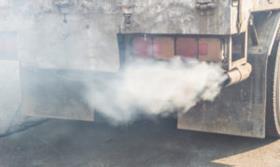With the demonisation of diesel, the haulage industry is being pulled into a low-emission future faster than many can cope with.
Evidence that diesel fumes are causing a health crisis in UK towns and cities has led to a pipeline of emissions-busting measures that could result in significant costs to hauliers.
These include the launch of London’s Ultra Low Emission Zones (ULEZ) in April 2019, one year earlier than planned, and Defra’s roll-out of as many as 35 clean air zones in cities across the country by 2019/20.
Both measures will require diesel vehicles entering these zones to meet Euro-6 standards or face a penalty charge.
These moves have left hauliers scrambling to upgrade their fleets to Euro-6 standards but now further government plans for the widespread adoption of Ultra Low Emission Vehicles (ULEV) by 2024 are raising industry concerns that those recently upgraded Euro-6 fleets could become obsolete within a decade.
FTA national policy director Christopher Snelling said these policies are uncoordinated, with unrealistic timescales and could place an unsustainable burden on some firms.
“It’s clear that at some point diesel emissions are going to be unacceptable in urban areas. The question is how far away are we from that reality? The industry needs to know so it can plan that transition,” he said.
Snelling argued that on current timescales, smaller firms relying on the second-hand market will struggle to bring their fleet to Euro-6 standard by the end of this decade.
“Small- and medium-sized operators will be the most badly affected by the introduction of clean air zones and there’s a danger they will be priced out of all sorts of work. And when the next iteration of clean air zones arrives, demanding ULEVs, they won’t be able to afford them and there will be a delay of years before these vehicles reach the second-hand market,” he said.
Greater guidance is needed so firms can plan for the long term, said Snelling. “The DfT needs to define what an ULEV is.
"Then there needs to be a gradual introduction of these vehicles, for example through government and local authority procurement, so industry has time to invest in production and purchase.”
On the ground
Firms are striving to upgrade their fleets to Euro-6 to meet the demands of clean air zones.
Liam Quinn, owner of York-based Quinns Transport, is selling a Euro-3 truck to part-fund the cost of buying a Euro-6 Scania to add to his fleet of four from the Swedish manufacturer.
He told Freightinthecity: “I can’t upgrade my fleet overnight. At £120,000 per truck, it’s a massive investment. I plan to change one truck a year, so by 2020 all my fleet will be Euro-6. But what if the government then tells me they’re rubbish? You can’t run a business like this.
"We need timescales, we should be rewarded for cutting our emissions and we need to know the government isn’t going to change the regulations overnight.”
Archer Transport (West Midlands), which runs 20 loads a day into London, is in the process of switching its 50-plus fleet to Euro-6 but is struggling to meet the April 2019 deadline set by London mayor Sadiq Khan.
MD Paul Archer said: “So far half the fleet is Euro-6 and that cost us £1.5m. We are buying six new trucks a year, but we still won’t have a fully compliant fleet by 2019. And that’s on top of the cost of all the cameras and sensors we need to meet safety regulations.
"There’s a chance they might specify high-visibility low cabs for London so I might be buying the wrong vehicle,” he said.
RHA national policy director Jack Semple underlined Archer’s concerns that Euro-6 trucks may not meet TfL’s proposed Direct Vision Standard in the capital.
He criticised TfL’s consultation documents on air quality and the Direct Vision Standard, which he said “appear to have been drafted in isolation from each other”.
However, TfL has refuted this.
Semple added: “It is a disgrace that expensive Euro-6 trucks could be obsolete in a few years’ time because of communication problems at TfL. We know of companies that have put their plans to buy Euro-6 vehicles on ice because of this.”
Archer also predicted the introduction of clean air zones will skew the second-hand market. “This is going to cause a glut of non-Euro-6 trucks. The price of second-hand trucks will hit the floor, making it more expensive to upgrade your fleet to Euro-6,” he warned.
Howard Cox, FairFuelUK founder, wants a fairer deal for hauliers. “They need financial help to retrofit vehicles and tax incentives to move to cleaner units.
"Rather than blame hardworking hauliers we need a debate about where the problem lies and government needs to pressure manufacturers to produce cleaner car engines.”
Are the facts correct?
Semple accused policy makers of failing to recognise the haulage industry’s progress in cutting emissions in recent years. He also claimed the DfT and TfL are using outdated emissions data for HGVs.

“We estimate between 35% and 40% of all HGV miles in the UK are done in Euro-6 trucks and by 2020 that will be more like 90%; so the NOx output from road haulage is tumbling.
"HGVs are way ahead of other vehicles in performing to their emissions standards, so what problem are they trying to solve?”
Pointing to the government’s former support for diesel and last November’s judicial review, which found government plans to cut emissions “woefully inadequate”, Semple argued the government has to bear some responsibility for the current level of emissions and offer scrappage schemes or tax relief to hauliers rather than pass the blame onto the haulage industry.
“To impose these costs on well-run firms and devalue their stock because government got it wrong is unacceptable, and if hauliers are not given more help we will see small firms going out of business,” he warned.













